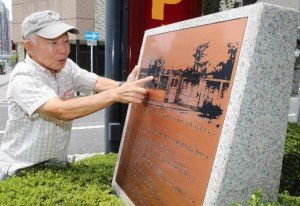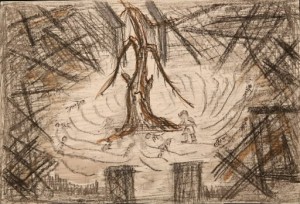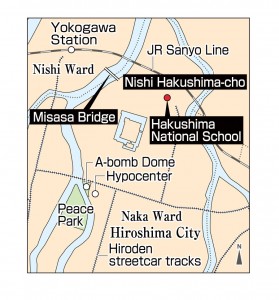Hiroshima: 70 Years After the A-bombing: Depicting the A-bombing 3
Oct. 23, 2014
Interrupted summer
Charred bodies of classmates in schoolyard
The picture shows the schoolyard at Hakushima National School (now Hakushima Elementary School) two days after the atomic bombing. Charred bodies lie at the base of a badly burned willow tree. The boy standing there looking at the scene is the artist, Hiroshima resident Yoshihiko Yagi, 80. At the time he was a fifth grader at the school.
“I wanted to depict the scene for my classmates, who had been with me until that morning,” Mr. Yagi said. Trapped under the collapsed wooden school building 1.5 km from the hypocenter, he narrowly escaped death. But he lost his father and four siblings, and his life changed completely. It was not until he was well into his 60s that he felt the desire to depict his A-bombing experiences.
Five family members missing
Mr. Yagi was born and raised in Nishi Hakushima-cho (now part of Naka Ward). His father ran a noodle-making business and sold noodles to the army facilities that occupied the area around Hiroshima Castle. Mr. Yagi’s mother died before the war.
At the time, Hakushima National School was located in Higashi Hakushima-cho. According to a history of the school, the first floor of the wooden building had been turned into barracks for the Aki Infantry Corps. The second floor was used by fifth and sixth graders and students in the advanced course who had not relocated to rural areas to avoid air raids.
On August 6, 1945, Mr. Yagi crawled out from under the collapsed school building and headed for home. As he walked through the expanse of debris, he repeatedly called out the names of his father and siblings, but there was no reply. The flames were closing in on him, so he set out for the village of Mita (now part of Asa Kita Ward), where his grandmother lived.
Two days later he returned to the city in search of his father Gihei, 52; sisters Shigeyo, 25, Tamie, 17, and Sakiko, 14; and younger brother Takeshi, 4. His school had been destroyed by fire, and flies had settled on the bodies of his classmates.
After experiencing the atomic bombing and losing his family, life after the war was difficult. “There wasn’t enough food, and going to school was out of the question,” he said. Mr. Yagi’s eldest brother got out of the army, returned home from China and got a job. Mr. Yagi took that opportunity to enter Kanon Junior High School in the spring of 1948, one year late. But he couldn’t afford the school expenses and was forced to quit school the next year.
He worked day and night, going from a job as a bicycle repairman to a fuel business, where he transported coal, and then to a food wholesaler. He married at the age of 28, and he and his wife had one daughter. When he was 37 they built a home in a new housing development in Yasuhigashi.
During that time he continued to search for his family. In 1968 the city began releasing a list of those whose remains are interred at the Peace Memorial Park Atomic Bomb Memorial Mound and whose identities had been learned. Every year he went to see it, but he stopped the year after his retirement. On the 50th anniversary of the atomic bombing he added the names of his father, sisters and brother to the grave at his family temple in Higashi Hakushima-cho with the inscription: “Died in the atomic bombing, August 6, 1945.”
In 2002 when, in cooperation with the Chugoku Shimbun, the Hiroshima studios of NHK again solicited A-bombing artwork, Mr. Yagi drew pictures depicting his experiences. He was 68. He got out the crayons his daughter had used when she was a girl and drew two pictures of the summer that disrupted his life.
That summer is symbolized by his destroyed school and the bodies he saw floating under the Misasa Bridge while searching for his family. On a separate piece of paper he wrote, “Their right to live as human beings and their dignity were stolen from them.” While mourning his dead classmates he realized how difficult it was for those who had survived to depict what they had seen.
Leading lawsuit seeking certification
Mr. Yagi now serves as the head of a 27-member group of Hiroshima plaintiffs who were not approved for A-bomb disease certification even after the central government relaxed the standards in 2008. When he was 76 he had a heart attack but his application for certification was rejected. When the standards were revised in 2013 he and eight others were certified but he stayed on as head of the group.
He does not belong to any atomic bomb survivors group but said he wanted to do even more than he had agreed to do. He learned that there were A-bomb survivors who could not file a lawsuit when they were rejected for certification because they could not cover the cost. “The people who really need aid can’t come forward,” he said. “They must be actively certified.”
Every year since drawing his A-bombing pictures he has talked about his experiences at local elementary and junior high schools. Recalling the course his life has taken since the atomic bombing, he tells the students: “All of you, who will lead the next generation, must safeguard the joy of being able to learn.” He said he has received 1,500 letters from students in response to his talks.
(Originally published on September 22, 2014)










